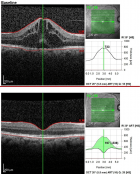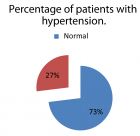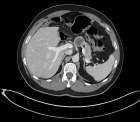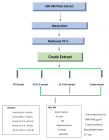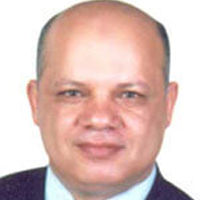Abstract
Research Article
C-reactive protein is associated with ventricular repolarization dispersion among patients with metabolic syndrome
Ylber Jani*, Atila Rexhepi, Bekim Pocesta, Ahmet Kamberi, Fatmir Ferati, Sotiraq Xhunga, Artur Serani, Dali Lala, Agim Zeqiri and Arben Mirto
Published: 27 June, 2019 | Volume 4 - Issue 2 | Pages: 043-052
Background: An increasing body of evidence indicates that inflammatory activation profoundly impacts the electrophysiological properties of cardiomyocytes. A marker of systemic inflammation such as C-reactive protein(CRP), is associated with all parameters of the Mtabolic syndrome(MetS) and that may result in adverse cardiac events via multiple effects, ultimately resulting in a prolongation of Action Potential duration (APD), and thereby of the QTC (QT corrected) interval on ECG.
Objective: We sought to investigate the influence of CRP levels on the prevalence of prolonged QT-dispersion and prolonged Tpeak-Tend –dispersion in the patients with MetS.
Methods: We conducted a multicenter observational cross-sectional study. The study population consisted of 200 patients with MetS, stratified in two groups:103 participants (50 females and 53 males) with level of CRP>3mg/l, and 97 participants (47 females and 50 males) with level of CRP<3mg/l), who attended outpatient visits at general cardiology Health Care Clinics during 1 calendar year. For the analysis of the ECG, we performed a manual measurement of the values using a digital caliper with measuring range of 0-150 mm, 0.01 mm resolution, and 0-100 ± 0.02 mm accuracy. QT interval dispersion was obtained by the difference between the maximum and the minimum QT intervals found in the 12-lead electrocardiogram. The Tpeak-Tend interval was obtained from the difference between QT interval and QTpeak interval.
Results: Prolonged QTC. dispersion, was found in 51.4% of participants with level of CRP>3mg/l and in 32.9% of with level of CRP<3mg/l, the differences were statistically significant. (p=0.004). The results showed that 51.4% participants with level of CRP>3mg/l had a prolonged Tpeak-Tend interval, and 32.9% of participants with level of CRP<3mg/l had prolonged Tpeak-Tend interval. Difference were statistically significant.( p=0.04). There were significant association of increased levels of CRP and QTC-dispersion (OR = 2.486, 95% CI 1.389-4.446).There were significant association of increased levels of CRP with Tpeak-Tend Dispersion (OR=2.239,95%CI 1.262-3.976). Prolonged QTC max. Interval OR=2.236,%CI 1.246-4.014),Prolonged Tp-Te-interval. (OR=2.367, 95%CI 1.327-4.222), also there were significant association of increased levels of CRP with BMI. (OR=1.154, 95%CI 1.095-1.227) and significant association of increased levels of CRP with presence of uncontrolled glicemia.(OR=1.779, 95%CI 1.014-3.12).
Conclusion: We think we proved the hypothesis that patients with MetS and high level of CRP have higher prevalence of QT- dispersion and Tpeak-Tend dispersion than patients with MetS and lower level of CRP. These findings have both epidemiological and clinical relevance, also these findings might lend further insight into potential mechanisms by which MetS is associated with adverse cardiac events.
Read Full Article HTML DOI: 10.29328/journal.jccm.1001040 Cite this Article Read Full Article PDF
Keywords:
C-reactive protein; QTC-dispersion; Tpeac-Tend dispersion in patient with metabolic syndrome
References
- Ford ES. Prevalence of the Metabolic Syndrome Defined by the International Diabetes Federation among adults in the U.S. Diabetes Care. 2005; 28: 2745–2749. Ref.: http://bit.ly/2FzEopG
- Ford ES, Li C, Zhao G. Prevalence and correlates of metabolic syndrome based on a harmonious definition among adults in the US. J Diabetes. 2010; 2: 180–193. Ref.: http://bit.ly/2ZUG3xN
- Pietro EL, Pier LC, Franco LP. Long QT Syndrome: An Emerging Role for Inflammation and Immunity. Front Cardiovasc Med. 2015; 2: 26. Ref.: http://bit.ly/2LmDBMF
- Evaristo FS, Alejandro TQ, Christian SP, Noemi GB, Cicero W, et al. Proinflamatory cytocines are soluble mediators linked with ventricular arrhythmias and contractile dysfunction in a rats model of metabolic syndrome. Oxid Med Cell Longev. 2017; 2017: 7682569. Ref.: http://bit.ly/2XE8DGc
- Watanabe H1, Tanabe N, Watanabe T, Darbar D, Roden DM, et al. Metabolic syndrome and risk of development of atrial fibrillation: the Niigata Preventive Medicine Study. Circulation. 2008; 117: 1255-1260. Ref.: http://bit.ly/2Nh8hRW
- Ridker PM, Buring JE, Cook NR, Rifai N. C-reactive protein, the metabolic syndrome, and risk of incident cardiovascular events: an 8-year follow–up of 14 719 initially healthy American women. Circulation. 2003; 107: 391-397. Ref.: http://bit.ly/2Lu4OwO
- Hussein AA1, Gottdiener JS, Bartz TM, Sotoodehnia N, DeFilippi C, et al. Inflammation and sudden cardiac death in a community-based population of older adults: the cardiovascular health study. Heart Rhythm. 2013; 10: 1425-1432. Ref.: http://bit.ly/2FEKYvo
- Elming H, Holm E, Jun L Torp-Pedersen C, Køber L, Kircshoff M, et al. The prognostic value of the QT interval and QT interval dispersion in all-cause and cardiac mortality and morbidity in population of Danish citizens. Eur Heart J.1998; 19: 1391-400. Ref.: http://bit.ly/2Ln3Get
- Fukuda K, Fukuda Y, Salles GF, Cardoso CR. Prolonged QT-intreval and QT-dispersion, are risk marker of arrhythmias and sudden cardiac death. Hypertens. 2009; 11: 231-237.
- The seventh report of Join National Committee on Prevention, Detection, Evaluation and treatment of High Blood Pressure. JAMA 2003; 289: 2550-2572. Ref.: http://bit.ly/2ITItaC
- America Diabetes Association. Standards for medical care for patient with diabetes mellitus. Diabetes Care. 2002; 25 (Suppl 1): S33-S49. Ref.: http://bit.ly/2ZSiYMw
- Center for disease control/American Heart association Workshop on inflammatory Markers, and Cardiovascular Disease: Application to clinical and public health practice: Atalanta, March 14-15, 2002. Atlanta, Ga. Centers for Disease Control and Prevention: 2002.
- Haverkamp W, Breithardt G, Camm AJ, Janse MJ, Rosen MR, et al. The potential for QT prolongation and proarrhythmia by non-antiarrhythmic drugs: clinical and regulatory implications. Report on a policy conference of the European Society of Cardiology. Eur Heart J. 2000; 21: 1216-1231. Ref.: http://bit.ly/2Xe4lpK
- Chiladakis J, Kalogeropoulos A, Arvanitis P, Koutsogiannis N, Zagli F, et al. Heart rate-dependence of QTc intervals assessed by different correction methods in patients with normal or prolonged repolarization. Pacing Clin Electrophysiol. 2009; 33: 553-560. Ref.: http://bit.ly/2XaM7FR
- Corrado D, Pelliccia A, Bjornstad HH, Vanhees L, Biffi A, et al. Cardiovascular pre-participation screening of young competitive athletes for prevention of sudden death: proposal for a common European protocol. Consensus Statement of the Study Group of Sport Cardiology of the Working Group of Cardiac Rehabilitation and Exercise Physiology and the Working Group of Myocardial and Pericardial Diseases of the European Society of Cardiology. Eur Heart J. 2005; 26: 516-524. Ref.: http://bit.ly/2Ln45O1
- Salles GF, Deccache W, Cardoso CR. Usefulness of QT-interval parameters for cardiovascular risk stratification in type 2 diabetic patients with arterial hypertension. J Hum Hypertens. 2005; 19: 241-249. Ref.: http://bit.ly/2X1s6wo
- Castro Hevia J, Antzelevitch C, Tornes Barzaga F, Dorantes Sanchez M, Dorticos Balea F, et al. Tpeak-Tend and Tpeak- Tend dispersion as risk factors for ventricular tachycardia/ventricular fibrillation in patients with the Brugada syndrome. J Am Coll Cardiol. 2006; 47: 1828-1834. Ref.: http://bit.ly/2RAR3xs
- Hussein AA1, Gottdiener JS, Bartz TM, Sotoodehnia N, DeFilippi C, et al. Inflammation and sudden cardiac death in community-based population of older adults: the cardiovascular health study. Heart Rhythm. 2013; 10: 1425-1432. Ref.: http://bit.ly/2FEKYvo
- Rocha VZ, Libby P. Obesity, inflammation and atherosclerosis. Nat Rew Cardiol. 2009; 6: 399-409. Ref.: http://bit.ly/2ZXw8YB
- Duncant DJ, Yang Z, Hopkins PM, Steele DS, Harison SM. TNF-α,IL-1β increase Ca2+ leak from the sarcoplamic reticulum and susceptibility to arrhythmias in rat ventricular myocites. Cell calcium. 2010; 47: 378-386. Ref.: http://bit.ly/2YgjHGP
- Bieganowska K, Sawicka-Parobczyk M, Bieganowski M, et al. Tpeak-tend interval in 12-lead electrocardiogram of healthy children and adolescent’s tpeak -tend interval in childhood. Ann Noninvasive Electrocardiol. 2013; 18: 344–351. Ref.: http://bit.ly/2IQA73b
- Letsas KP, Weber R, Astheimer K, Kalusche D, Arentz T. Tpeak-Tend interval and Tpeak-Tend/QT ratio as markers of ventricular tachycardia inducibility in subjects with Brugada ECG phenotype. Europace. 2010; 12: 271–274. Ref.: http://bit.ly/2xjfaY4
- Castro Hevia J, Antzelevitch C, Tornés Bárzaga F, Sánchez MD, Balea FD, et al. Tpeak-Tend and Tpeak-Tend dispersion as risk factors for ventricular tachycardia/ventricular fibrillation in patients with the Brugada syndrome. J Am Coll Cardiol. 2006; 47: 1828–1834. Ref.: http://bit.ly/2RAR3xs
- Ylmaz H, Ozcan KS, Sayar N, Kemaloglu T, Gungor B, Erer B, et al. Metabolic syndrome is associated with atrial electrical and mechanical dysfunction. Med Princ Pract. 2015; 24: 147-152. Ref.: http://bit.ly/2ZPiUwP
- Karakas MF, Buyukkaya E, Kurt M, Motor S, Akcay AB, Karakas E, et al. Serum pentraxin-3 levels are associated with the severity of metabolic syndrome. Med Princ Pract. 2013; 22; 274-279. Ref.: http://bit.ly/2REAwc8
- Karaagac K, Emul A, Tenekecioglu E, Agca FV, Ozluk OA, et al. The Effects of Metabolic Syndrome on TpTe Interval and TpTe/QT Ratio in Patients with Normal Coronary Arteries. Eurasian J Med. 2014; 46: 182-186. Ref.: http://bit.ly/2KGLZXY
- Paul MR, Julie EB, Nancy RC, Nader R. C-Reactive Protein, the Metabolic Syndrome, and Risk of Incident Cardiovasular Events. Circulation. 2003; 107: 391-397. Ref.: http://bit.ly/2LoMmGb
- Masugata H, Senda S, Inukai M, Murao K, Tada S, et al. Association between hih-sensitivity C-reactive protein and left ventricular diastolic function assessed by echocardiography in patients with cardiovascular risk factors. J Exp Med. 2011; 223: 263-268. Ref.: http://bit.ly/2X8RMfs
- Jani Y, Rexhepi A, Pocesta B, Xhunga S, Serani A, et al. Influence of C-Reactive Protein and Metabolic Syndrome on the Prevalence of Subclinical Left Ventricular Diastolic Dysfunction. American J Epidemiol Public Health. 2018; 2: 027-030. Ref.: http://bit.ly/2ITbiUz
- Suis B, Heuten S, De Wolf D, Verherstraeten M, deBeck LO, et al. Glycemia and corrected QT Interval Prolongation in jung Type-1 diabetic patients: What is the relation? Diabetes Care. 2006; 29: 427-429. Ref.: http://bit.ly/2XAbb8h
- Costa EC, Conclaves AA, Areas MA, Morgabel RG. Effects of Metformin on QTc interval dispersion of Diabetics rats. Arquivos de Cardiologia. 2008; 90: 232-238. Ref.: http://bit.ly/2XEdyqI
Figures:
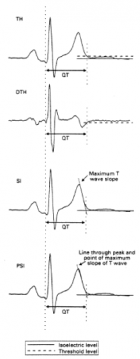
Figure 1
Similar Articles
-
Non-hemodynamic factors associated to the risk of developing hypertensive cardiopathyAlexis Álvarez-Aliaga*,Julio César González-Aguilera,Liliana del Rosario Maceo-Gómez,Lic David del Llano Sosa,Raúl Leyva-Castro,Rosa Ojeda-Vázquez. Non-hemodynamic factors associated to the risk of developing hypertensive cardiopathy. . 2017 doi: 10.29328/journal.jccm.1001017; 2: 068-084
-
C-reactive protein is associated with ventricular repolarization dispersion among patients with metabolic syndromeYlber Jani*,Atila Rexhepi,Bekim Pocesta,Ahmet Kamberi,Fatmir Ferati,Sotiraq Xhunga, Artur Serani,Dali Lala,Agim Zeqiri,Arben Mirto. C-reactive protein is associated with ventricular repolarization dispersion among patients with metabolic syndrome. . 2019 doi: 10.29328/journal.jccm.1001040; 4: 043-052
-
The effect of anemia on serum hepcidin levels in patients with heart failureBetul Borku Uysal*,Feray Akbas,Esma Altunoglu,Gulhan Ipek Denız,Duygu Uysal,Harun Uysal,Hanife Usta Atmaca,Yasin Yuksel,Hale Aral,Guven Cetın,Cem Ar M,Fusun Erdenen. The effect of anemia on serum hepcidin levels in patients with heart failure. . 2019 doi: 10.29328/journal.jccm.1001059; 4: 159-163
-
Effect of hemodialysis session on acute changes in inflammatory and cardiovascular risk biomarkersBernardo-Alio Lavín Gómez*,María-Teresa García Unzueta,Armando-Raúl Guerra Ruiz,Sonia Pérez San-Martín,Ana Berja,Natalia Fañanás Rodríguez,Sara Díez Espejo,Domingo González-Lamuño Leguina. Effect of hemodialysis session on acute changes in inflammatory and cardiovascular risk biomarkers. . 2020 doi: 10.29328/journal.jccm.1001077; 5: 004-010
Recently Viewed
-
The Risk-Adjusted Impact of Intraoperative Hemofiltration on Real-World Outcomes of Patients Undergoing Cardiac SurgeryMatata BM*,Shaw M. The Risk-Adjusted Impact of Intraoperative Hemofiltration on Real-World Outcomes of Patients Undergoing Cardiac Surgery. J Clini Nephrol. 2017: doi: 10.29328/journal.jcn.1001001; 1: 001-010
-
Stroke Mimics: Insights from a Retrospective Neuroimaging StudyLucia Monti*, Davide del Roscio, Francesca Tutino, Tommaso Casseri, Umberto Arrigucci, Matteo Bellini, Maurizio Acampa, Sabina Bartalini, Carla Battisti, Giovanni Bova, Alessandro Rossi. Stroke Mimics: Insights from a Retrospective Neuroimaging Study. J Neurosci Neurol Disord. 2023: doi: 10.29328/journal.jnnd.1001083; 7: 094-103
-
Estimating the Minimum Possible Deceleration of Cosmic Expansion Post-inflationDev Sharma*. Estimating the Minimum Possible Deceleration of Cosmic Expansion Post-inflation. Int J Phys Res Appl. 2024: doi: 10.29328/journal.ijpra.1001089; 7: 080-085
-
Giant cellular angiofibroma of the vulva: case reportAna Ribeiro*,Isabel Ferreira,Filomena Ramos. Giant cellular angiofibroma of the vulva: case report. Clin J Obstet Gynecol. 2019: doi: 10.29328/journal.cjog.1001016; 2: 003-005
-
Coronavirus and pHViktor Zinchenko* and Adriana Barylyak. Coronavirus and pH. Int J Clin Virol. 2023: doi: 10.29328/journal.ijcv.1001052; 7: 003-006
Most Viewed
-
Evaluation of Biostimulants Based on Recovered Protein Hydrolysates from Animal By-products as Plant Growth EnhancersH Pérez-Aguilar*, M Lacruz-Asaro, F Arán-Ais. Evaluation of Biostimulants Based on Recovered Protein Hydrolysates from Animal By-products as Plant Growth Enhancers. J Plant Sci Phytopathol. 2023 doi: 10.29328/journal.jpsp.1001104; 7: 042-047
-
Feasibility study of magnetic sensing for detecting single-neuron action potentialsDenis Tonini,Kai Wu,Renata Saha,Jian-Ping Wang*. Feasibility study of magnetic sensing for detecting single-neuron action potentials. Ann Biomed Sci Eng. 2022 doi: 10.29328/journal.abse.1001018; 6: 019-029
-
Sinonasal Myxoma Extending into the Orbit in a 4-Year Old: A Case PresentationJulian A Purrinos*, Ramzi Younis. Sinonasal Myxoma Extending into the Orbit in a 4-Year Old: A Case Presentation. Arch Case Rep. 2024 doi: 10.29328/journal.acr.1001099; 8: 075-077
-
Pediatric Dysgerminoma: Unveiling a Rare Ovarian TumorFaten Limaiem*, Khalil Saffar, Ahmed Halouani. Pediatric Dysgerminoma: Unveiling a Rare Ovarian Tumor. Arch Case Rep. 2024 doi: 10.29328/journal.acr.1001087; 8: 010-013
-
Physical activity can change the physiological and psychological circumstances during COVID-19 pandemic: A narrative reviewKhashayar Maroufi*. Physical activity can change the physiological and psychological circumstances during COVID-19 pandemic: A narrative review. J Sports Med Ther. 2021 doi: 10.29328/journal.jsmt.1001051; 6: 001-007

HSPI: We're glad you're here. Please click "create a new Query" if you are a new visitor to our website and need further information from us.
If you are already a member of our network and need to keep track of any developments regarding a question you have already submitted, click "take me to my Query."






